Is Hog Hill too tough?
I have heard considerable discussion about this. Some people are even saying that HH is 'not for them' and they'll not be back.
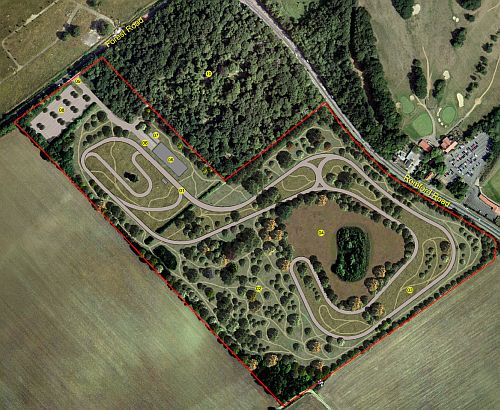
|
This is an aerial impression of the circuit which as to the layout is fairly (if not perfectly) true to what has actually been built. There aren't as many trees - but then we can't have everything. |
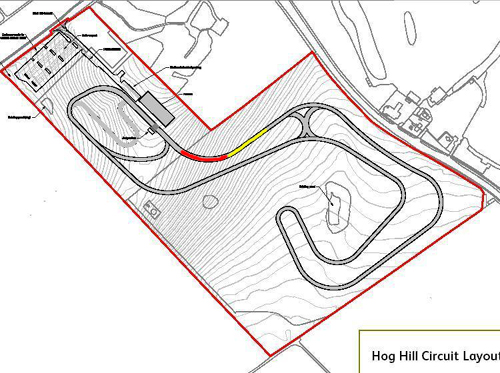
|
The problem is with riding anti-clockwise over a short part of the course. The road climbs gently at first (amber) then
kicks very hard around the top corner (red) before a very short run to the finish line.
The objectors (moaners, if you will) are saying that the steepness of the final (red) approach makes the course too hard for all but super-light mountain goats. It is true that the peloton in the first race I rode there was reduced from 70+ to about 20 at the end. |
The objections have come from lower-level riders, generally 4th Cats, from Veterans, and from those concerned about those new to cycling who want to 'give it a go'. These are, in the case of 4ths and Vets, the majority of users; in the case of newcomers, that's where our future stars will come from, of course.
The obvious answer to this is to ride the circuit clockwise. But this multi-million pound venue was designed to be ridden both directions - it seems a shame just to abandon one of them.
It's fairly clear that Eastway User Group were aware of this situation before construction began and spotted various improvements which could have been to the circuit, as shown in the sketch. (The pic below is a cut version of one which again can be found here http://www.eastway7506.btinternet.co.uk/Memories.html, scroll to the bottom).
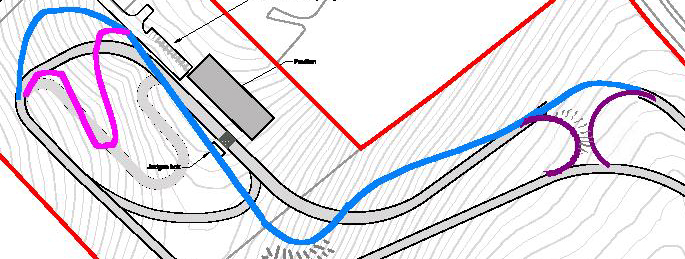
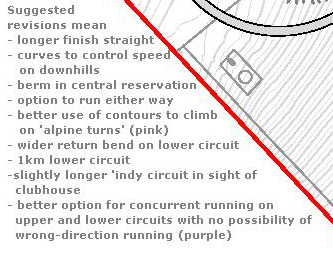
|
The benefits of this revision are listed left, and were identified before the circuit was built.
I find it odd that none of the proposed changes were implemented, even though they were from the primary user group for the circuit.
|
- What!! We've just spent a squillion quid and straight away you propose more -- no way!
- No complex construction is 100% perfect from the outset; what we need to know is
- what's wrong?
- what could to be done to fix it?
- what will it cost?
What could be done is to add a new loop to the exising course
What it will cost is not zero, but is surely a tiny amount in the overall scheme of things.
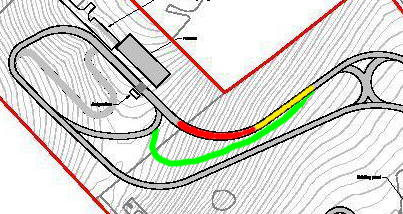
|
The sketches are slightly deceptive; there's more space between the two carriageways than is suggested here.
The opportunity does exist to adapt the idea(s) put forward by (I presume) Michael Humphreys,
albeit in a much reduced form now that the circuit has been built. Assuming of course (!) that money can be found to do it.
The route shown in the sketch in green would, I believe, simply ease the gradient of the climb; it does not actually reduce the amount of climbing that has to be done. |
There is no need to abandon the existing circuit, the additional bit would be segued into it. This would mean that, for instance, in some races the steep climb could be used every so often, perhaps on a 'prime' lap, or just to provide some variety.
Conclusion
Hog Hill is a fabulous venue. But it may be that one small feature of it is going put off some potential users. These users are those at the lower end of the ability scale (the majority, of course), and those who are just trying cycling and the circuit for the first time. It is of course the first timers we want to encourage to come back!To build an alternative slightly longer and easier ascent to the finish line would be a tiny incremental cost compared to the money that's alreay been invested, but could go a disproportionately long way to helping that investment pay off in sporting terms. It is still possible that young people of around 16,17 or 18 years of age coming to the sport for the first time in 2008 could be our Olympians in 2012. We need to encourage as many as possible to 'have a go' to find those few, and a modification like the one proposed here will widen the net.
 The one that's most remarkable to meis that the upper and lower circuits do
now actually meet, as shown, rather than turn separately as the purple additions to the sketch suggest. This
means that the two cannot, for clear safety reasons, be used at the same time. The possibilty of collisions is obvious.
The one that's most remarkable to meis that the upper and lower circuits do
now actually meet, as shown, rather than turn separately as the purple additions to the sketch suggest. This
means that the two cannot, for clear safety reasons, be used at the same time. The possibilty of collisions is obvious.